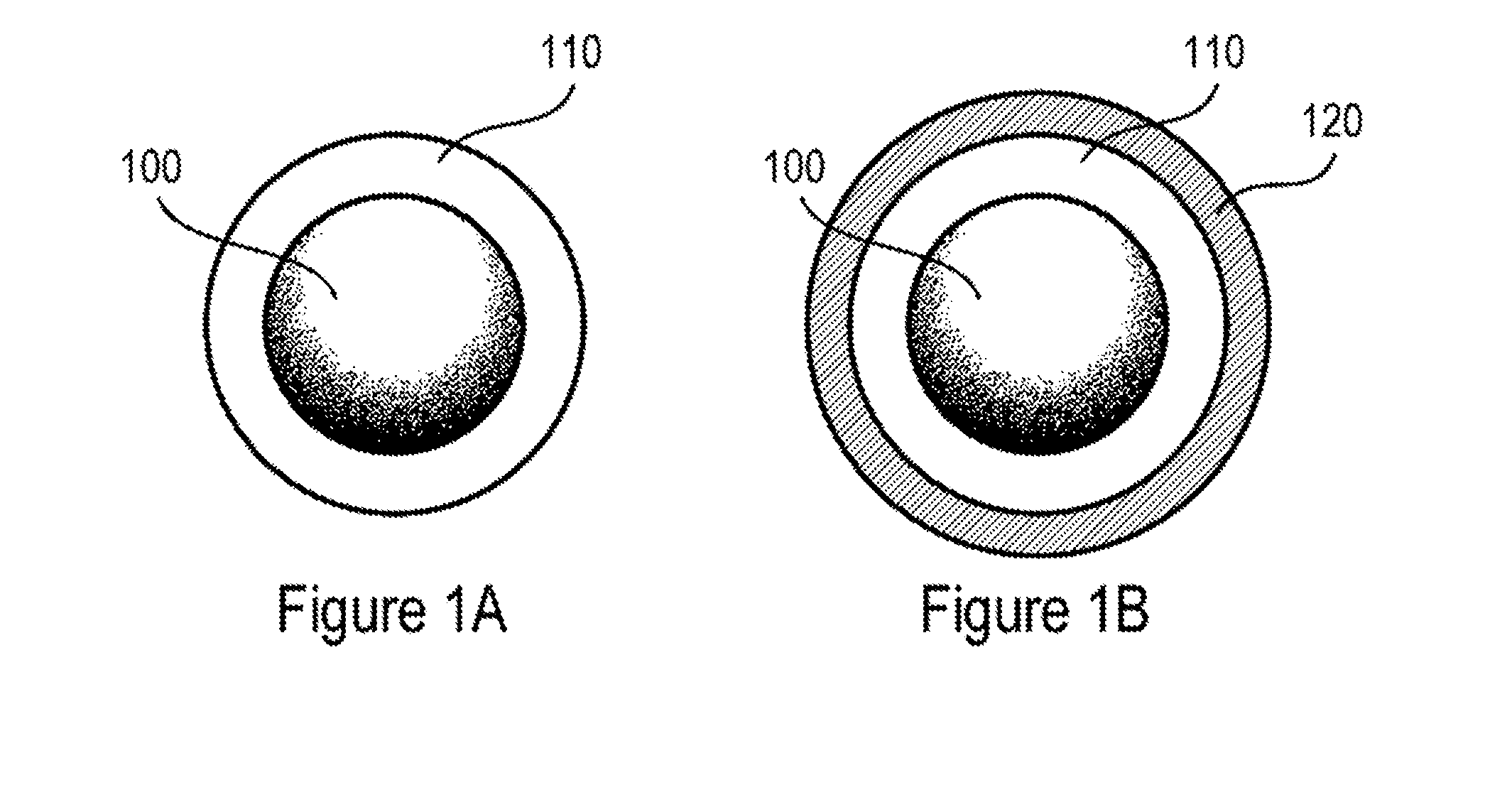Encapsulated particles
a technology of encapsulated particles and particles, applied in the field of material systems, can solve the problems of inability to fully absorb silicon oxide, inability to absorb silicon oxide,
- Summary
- Abstract
- Description
- Claims
- Application Information
AI Technical Summary
Benefits of technology
Problems solved by technology
Method used
Image
Examples
example 1
Stability of Aluminum Silicate Shells Compared to Silicon Oxide Shells
[0151]In a 20 mL glass scintillation vial, 5 mL of 80 nm polyvinylpyrollidone (PVP) capped Biopure silver at a concentration of 1 mg / mL (nanoComposix, Inc.) was diluted with 10 mL of EtOH. The mixture was heated to 60° C. and 79 μL of 28% aqueous ammonium hydroxide solution was added followed by 18.3 μL of a 20 μL / mL solution of aminopropyltrimethoxysilane in ethanol. After fifteen minutes, 91.6 μL of a 20 μL / mL TEOS solution was added. The vial was capped and allowed to stir over night. Silicon oxide-shelled silver nanoparticles produced using this method are shown in FIG. 8.
[0152]250 μL of the silicon-oxide-shelled silver as synthesized was diluted to 1 mL in a microcentrifuge tube with either 0.1% 20000 MWT PEG solution or 5 mM AlCl3 and allowed to incubate for 10 minutes. The PEG and AlCl3 solutions were spun for 5 minutes at 10000 rpm in a microcentrifuge. The supernatant was removed and each of the solutions...
example 2
Characterization of Aluminum Silicate-Shelled Silver Nanoparticles
[0153]Aluminum silicate-shelled silver nanoparticles were analyzed to determine the core size, shell thickness and elemental composition. FIG. 8 shows the TEM image of the particles. The contrast difference in the TEM micrograph between the silver core and the silicon oxide shell can be used to determine the diameter of the core and the thickness of the shell. ImageJ software was used to analyze the images. 100 particles were counted and the core size was determined to be 83.0±6.0 nm and the shell thickness was 26.1±2.9 nm.
[0154]The elemental composition of the different components of the particle is determined by dissolution of either the core, the shell or both and subsequent measurement by ICP-MS. The aluminum silicate coated silver particle was mixed with nitric acid which diffused through the aluminum silicate shell and dissolved the silver. The silver ions were isolated from the aluminum silicate by centrifugati...
example 3
Stability of Aluminum Silicate Shells Compared to Thermally Condensed Silicon Oxide Shells
[0155]The effect of thermal treatments and aluminum treatments on silicon oxide was compared. In a 20 mL glass scintillation vial, 5 mL of 80 nm polyvinylpyrollidone (PVP) capped Biopure gold at a concentration of 1 mg / mL (nanoComposix, Inc.) was diluted with 10 mL of EtOH. The mixture was heated to 60° C. and 79 μL of 28% aqueous ammonium hydroxide solution was added followed by 18.3 μL of a 20 μL / mL solution of aminopropyltrimethoxysilane in ethanol. The solution was heated for 10 hours at 60° C. in a sealed scintillation vial. TEM analysis showed a silicon oxide shell on the gold nanoparticles after the heating step. 333 μL of the heat treated material was diluted to 1 mL with DI water, spun out at 4400 rpm in a microcentrifuge tube and resuspended in water. The supernatant was decanted, the pelleted material taken back up in 1 mL water and centrifuged again. This was then repeated a third t...
PUM
| Property | Measurement | Unit |
|---|---|---|
| Length | aaaaa | aaaaa |
| Fraction | aaaaa | aaaaa |
| Fraction | aaaaa | aaaaa |
Abstract
Description
Claims
Application Information
 Login to View More
Login to View More - R&D
- Intellectual Property
- Life Sciences
- Materials
- Tech Scout
- Unparalleled Data Quality
- Higher Quality Content
- 60% Fewer Hallucinations
Browse by: Latest US Patents, China's latest patents, Technical Efficacy Thesaurus, Application Domain, Technology Topic, Popular Technical Reports.
© 2025 PatSnap. All rights reserved.Legal|Privacy policy|Modern Slavery Act Transparency Statement|Sitemap|About US| Contact US: help@patsnap.com



